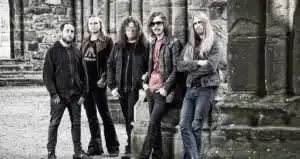King Crimson: Architects of Progressive Evolution
Few bands in the history of modern music have had the audacity, creativity, and sheer nerve to constantly reinvent themselves while challenging the conventions of popular rock music. One such band is King Crimson—a name that commands reverence in the progressive rock sphere and well beyond it. From their explosive debut in 1969 to their live reinventions of the 2010s, King Crimson remains a dynamic musical force defined by perpetual transformation, uncompromising artistry, and an almost mystical level of precision.
The Birth of the Crimson King: 1969 and the Prog Breakthrough
King Crimson was formed in 1968 in London by guitarist and conceptualist Robert Fripp, along with lyricist Peter Sinfield, multi-instrumentalist Ian McDonald, bassist/vocalist Greg Lake, and drummer Michael Giles. The lineup would not remain stable for long, but their brief collaboration resulted in one of the most groundbreaking debut albums in music history: In the Court of the Crimson King (1969).
The album was a bold departure from the psychedelic rock that dominated the late 1960s. Featuring Mellotron-soaked atmospheres, jazz-inflected rhythms, classical motifs, and surreal lyrics, it introduced a new musical paradigm. “21st Century Schizoid Man” alone captured the chaos of the modern world with its distorted vocals, jagged riffs, and unrelenting energy. The title track, on the other hand, offered a majestic, haunting contrast.
This debut was not just successful—it was influential. Critics and fans alike recognized it as a turning point that gave rise to the progressive rock movement, laying the foundation for bands like Genesis, Yes, and Emerson, Lake & Palmer.
Fragmentation and Reinvention: The 1970s Lineups
If there is one constant in the history of King Crimson, it’s change. After the first album’s success, Ian McDonald and Michael Giles left the band, followed shortly by Greg Lake, who went on to form ELP with Keith Emerson and Carl Palmer. Fripp, determined to keep the band alive, took a more controlling role and began reshaping the group’s identity.
1970–1972: The Search for Structure
The next two albums, In the Wake of Poseidon (1970) and Lizard (1970), were sonically ambitious but reflected the instability in the lineup. With jazz, medieval, and chamber influences, these albums were critically divisive but foreshadowed future directions. Islands (1971) continued the trend, offering softer tones and pastoral themes, showing Fripp’s willingness to experiment with compositional balance.
1973–1974: The Crimson Beast Awakens
The arrival of John Wetton (bass/vocals), Bill Bruford (drums), David Cross (violin/keys), and Jamie Muir (percussion) marked a new phase. This era produced some of the band’s most celebrated and heavy works:
- Larks’ Tongues in Aspic (1973): Fused Eastern percussion, metal riffing, and experimental soundscapes.
- Starless and Bible Black (1974): A more improvisational approach with live recordings integrated into studio work.
- Red (1974): A raw, aggressive, and emotionally intense album, often cited as one of the most influential in post-rock and progressive metal circles.
Shortly after Red, Fripp announced the band’s dissolution, famously stating that “King Crimson is completely over for ever and ever.”
The Discipline Era: 1980s Innovation
Six years later, Fripp resurrected King Crimson with a new lineup and sound. Teaming up with Adrian Belew (guitar/vocals), Tony Levin (bass/Chapman Stick), and returning drummer Bill Bruford, the band released Discipline (1981). This incarnation embraced New Wave and minimalism, replacing Mellotrons and epics with interlocking guitar patterns and rhythmic complexity.
Beat (1982) and Three of a Perfect Pair (1984) followed, completing a trilogy of sleek, intelligent, and challenging albums. Belew’s quirky vocals and lyrical surrealism complemented Fripp’s abstract compositions perfectly.
This version of King Crimson was not only progressive—it was modern, tight, and rhythmically mesmerizing. Their live performances from this era showcased their machine-like precision, further solidifying their reputation for technical brilliance.
Double Trio and the Heavy Rebirth: 1990s–2000s
In 1994, Fripp returned with yet another reinvention: the Double Trio. This consisted of six members—two drummers (Bruford and Pat Mastelotto), two bassists/stick players (Levin and Trey Gunn), and two guitarists (Fripp and Belew).
THRAK (1995) was the product of this configuration, balancing ethereal ambiance with blistering force. Songs like “VROOOM” and “Dinosaur” combined power, dissonance, and layered instrumentation.
Eventually, the group slimmed down into a “double duo,” entering what Fripp dubbed the ProjeKcts phase—essentially experimental offshoots meant to deconstruct and reconstruct King Crimson’s musical DNA. Albums like The ConstruKction of Light (2000) and The Power to Believe (2003) took these experiments further into electronic, ambient, and industrial territory.
The Crimson King Returns: 2010s and Beyond
In 2013, to the surprise of fans, Fripp announced a new seven-piece lineup, including three drummers (Mastelotto, Gavin Harrison, and Bill Rieflin), Mel Collins (sax/flute), Levin, Jakko Jakszyk (vocals/guitar), and himself.
This formation didn’t record new studio albums, but their live shows were legendary. Performing classics from the entire catalogue—including previously neglected works like “Lizard” and “Islands”—the band delivered re-imagined versions with bombastic clarity and jazz-inflected elegance. Concerts were structured like symphonic performances—disciplined, expansive, and majestic.
Fripp’s final retirement from touring in 2021 might mark the end of Crimson as a live act, but the band’s music continues to inspire musicians and listeners globally.
Musical Philosophy and Legacy
What makes King Crimson so enduring and revered?
- Constant Evolution: They never settled on a “signature sound.” Every era brought new ideas, lineups, and styles.
- Uncompromising Vision: Fripp resisted record label pressure and mainstream trends.
- Influence: Their music shaped the sound of bands like Tool, Porcupine Tree, Dream Theater, Opeth, and even Radiohead.
- Technical Mastery: Musicianship at its finest, with intricate time signatures, modal shifts, and experimental textures.
- Live Power: Their concerts were intellectual experiences, often demanding as much from the listener as the performers.
Essential Albums to Explore
- In the Court of the Crimson King (1969) – The origin of prog.
- Red (1974) – Heavy, dark, and emotionally powerful.
- Discipline (1981) – A cerebral masterpiece of rhythm and order.
- THRAK (1995) – Raw, thunderous, and complex.
- Live in Chicago (2017) – A masterful snapshot of the latest lineup in its prime.
Final Thoughts
King Crimson is less a band and more a living art project. They embody the core values of progressive music: innovation, complexity, emotion, and fearlessness. Whether through the cataclysmic fury of “Larks’ Tongues in Aspic” or the delicate elegance of “Starless,” King Crimson continues to challenge, to question, and to elevate rock to realms few others dare to explore.





